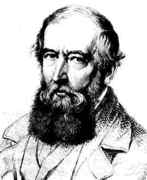Person: Steiner, Jakob

Jakob Steiner was one of the greatest contributors to projective geometry.
Mathematical Profile (Excerpt):
- Jakob, however, wanted something better for himself but his parents were delighted to have his help with their business.
- Pestalozzi ran his innovative school in the town from 1805 to 1825 and Steiner entered in the spring of 1814.
- The fact that Steiner was unable to pay anything towards his education at the school was not a problem, for Pestalozzi wanted to try out his educational methods on the poor.
- Pestalozzi's school had a very significant effect on Steiner's attitude both to the teaching of mathematics and also to his philosophy when undertaking research in mathematics.
- In the autumn of 1818, Steiner left Yverdom and travelled to Heidelberg where he earned his living giving private mathematics lessons.
- Steiner's time as a mathematics teacher at the Werder Gymnasium proved a difficult one.
- Perhaps, understandably, Zimmermann wanted Steiner to teach his courses using a textbook written by Zimmermann himself.
- Steiner, who was a firm believer in Pestalozzi's methods of teaching, used those methods in the classroom.
- Zimmermann claimed that these were only suitable for elementary courses, and Steiner was dismissed in the autumn of 1822.
- Carl Jacobi, although eight years younger than Steiner, was a student at the University of Berlin at this time and soon Steiner and Jacobi became friends.
- In 1825 Steiner was appointed as an assistant master at the Technical School of Berlin.
- The type of difficulties that Steiner had experienced at the Werder Gymnasium again arose at the Technical School.
- Klöden, almost certainly correctly, believed that Steiner was not giving him the respect that he deserved.
- Despite the bad atmosphere, Steiner managed to carry out some outstanding mathematical research while teaching at the Technical School.
- We have already mentions that Steiner became friendly with Jacobi, but he also became friendly with other influential mathematicians in Berlin.
- Steiner became an early contributor to Crelle's Journal, the Journal für die reine und angewandte Mathematik, which was the first journal devoted entirely to mathematics founded.
- The first volume of the journal appeared in 1826 and contains Steiner's first long work, Einige geometrische Betrachtungen Ⓣ(Some geometric considerations).
- It is also important for Steiner's use of the principle of inversion in many of the proofs.
- This paper was the first of 62 papers which Steiner published in Crelle's Journal.
- In 1832 Steiner published his first book Systematische Entwicklung der Abhangigkeit geometrischer Gestalten voneinander Ⓣ(Systematic development of the dependence of geometric shapes on each other).
- Much of the material had already appeared in Steiner's papers over the preceding six years.
- Soon Steiner was being honoured for his remarkable achievements.
- He was in Rome in 1844 and on this visit he spent his time investigating a fourth order surface of the third class now called the 'Roman surface' or 'Steiner surface'.
- He discovered the 'Steiner surface' which has a double infinity of conic sections on it.
- The 'Steiner theorem' states that the two pencils by which a conic is projected from two of its points are projectively related.
- Another famous result is the 'Poncelet-Steiner theorem' which shows that only one given circle and a straight edge are required for Euclidean constructions.
- Today these ellipses are called the 'Steiner ellipses'.
- He also introduced Steiner curves, discussed tangents at points of inflection, double tangents, cusps and double points.
- This wealth of material is presented, however, without any indication of the proofs which Steiner had found.
- Steiner disliked algebra and analysis and believed that calculation replaces thinking while geometry stimulates thinking.
- Despite being a mathematical genius, in other ways Steiner was a difficult person.
- The last ten years of Steiner's life were increasingly difficult through illness.
- One third of this fortune went to the Berlin Academy to found the Steiner Prize.
Born 18 March 1796, Utzenstorf, Switzerland. Died 1 April 1863, Bern, Switzerland.
View full biography at MacTutor
Tags relevant for this person:
Algebra, Geometry, Group Theory, Origin Switzerland, Physics, Set Theory
Thank you to the contributors under CC BY-SA 4.0! 

- Github:
-

- non-Github:
- @J-J-O'Connor
- @E-F-Robertson
References
Adapted from other CC BY-SA 4.0 Sources:
- O’Connor, John J; Robertson, Edmund F: MacTutor History of Mathematics Archive
